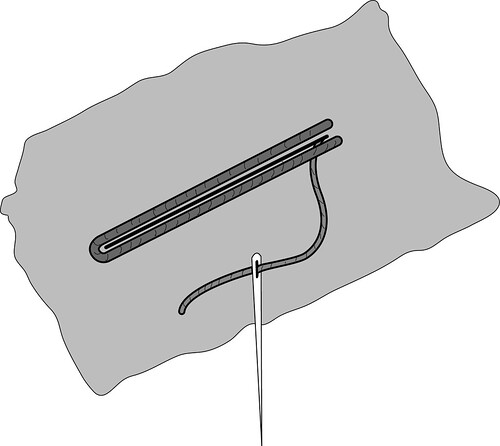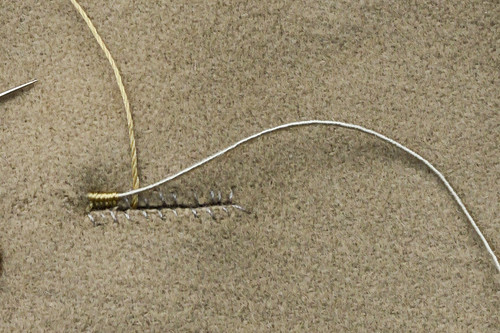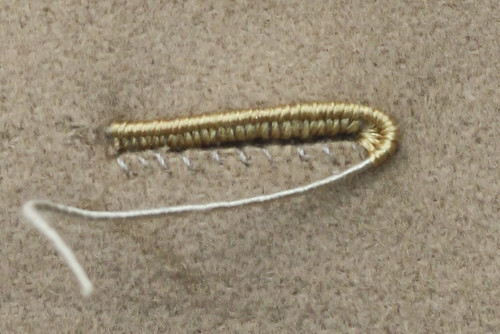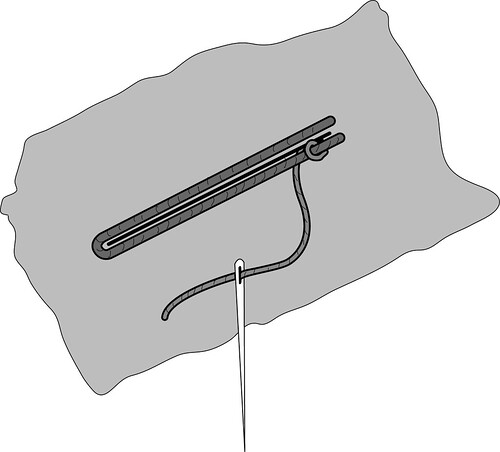For Mike, who says he still doesn't get it.
I hope this helps.
(Sorry that the illustrations are rotated from the photos, but maybe this will actually help)
1.
Cut through the cloth, overcast, and lay a length of gimp. Do not wax the silk twist. Unlike regular buttonholes which start from the top, the twist must be anchored on the bottom of the hole (on the wrong side).
Feed the needle through the slit, then underneath the gimp.


2.
Wrapping around the gimp, insert the needle underneath the gimp, about 1/16" away from the slit edge.


3. Pull tight.


4. Repeat by feeding the needle up through the slit. When taking the next stitch, insert the needle exactly next to the previous stitch, and do not leave any space between the two. You may need to nudge the stitch with your thumb to pack them in tight.











14 comments:
Fantastic explanation! Thank you!
Thank you so much. :-)
How have the buttonholes with the separated twist been going?
I wish mine were as beautiful as yours...
Hello,
I know this is a bit off topic, but from reading some of your old post, I learned that it takes a tremendous amount of time to apply facings by hand. But I don't quite understand the advantages in doing that, could you help me by explaining the difference?
Best,
Ian
Benjamin- I've been busy with my move lately so no buttonholes in a while.
SP- thank you.
Ian- facings are not applied dry- there is fullness worked into certain parts of it to allow the lapel to roll and sit flat. When you machine the facing, you baste it into place inside out, and you have to have a very good sense of exactly how much fullness needs to go where. Doing it by hand, you work on the right side and you can check the fullness as you go to make sure everything is proper.
Hey Jeffery,
I know this is a bit off topic but can you explain in a few sentences the difference between facings doing by hand vs. machine?
thanks,
Tom
Unfortunately I still don't get it with the illustrations.
Hey Jeff,
Would you know anymore information about CAP Tailleur Homme in Paris? Can't seem to find it on the web, and It keeps failing when I try to email you my email. Any help would be greatly appreciated. Awesome blog by the way.
Thanks,
Mike
Fabulous! I love hand made buttonholes. It is not so difficult and time consuming as many would thought. This is a great tutorial.
At last, after working on the ordinary keyhole buttonhole, I returned to this explanation....and I got it. Thank you so much Jeffery. My family are amused by my obsession with learning about handworked buttonholes..Couldn't have done it without your help
Bonjour,
Concernant les boutonnière à la main, vous utilisez un fil gris qui sert de support à l'enroulage du fil de soie par la suite (gimp). Comment s'appelle ce fil gris ? Est-ce un fil de soie très épais ou bien un cordon rigide ?
Claraines- Le fil (gimp) que j'utilise s'appelle Agreman. Il est produit et vendu par Gutermann. Ca se trouve à Paris, mais il y a également une source en Angleterre qui livre partout en Europe-
http://www.theliningcompany.co.uk/catalog/product_info.php?products_id=2622&osCsid=xdatidpqmoiv
Outstanding!
Can we get a video of this artwork?
Post a Comment